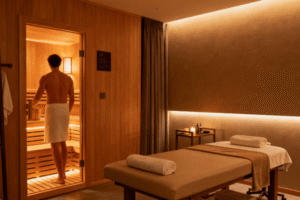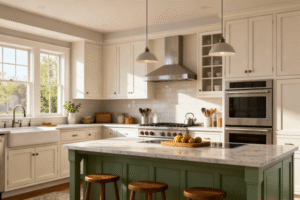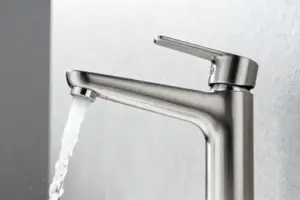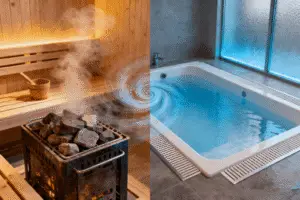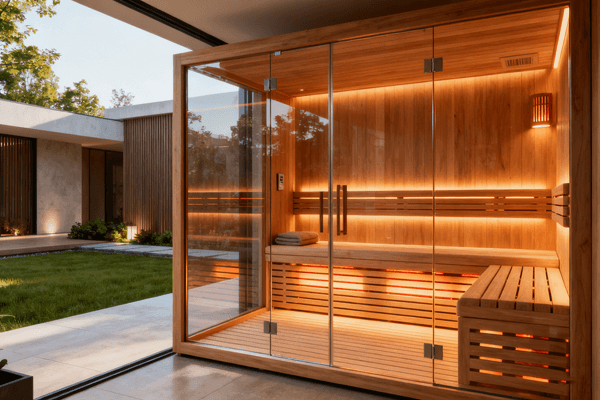
Saunas can boost wellness, but poor setup wastes benefits. I guide you to design, place, and use your sauna effectively.
This guide covers indoor/outdoor placement, infrared tips1, ventilation2, structure, and Holie case studies for optimal wellness.
Explore carefully to get the most from your sauna setup and enjoy full benefits safely.
Infrared Sauna Tips for Safe and Effective Use?
Infrared saunas promise health, yet misuse reduces benefits. Learn how to optimize temperature, time, and safety for full results.
Using infrared saunas correctly improves muscle recovery, relaxation, and overall well-being safely.
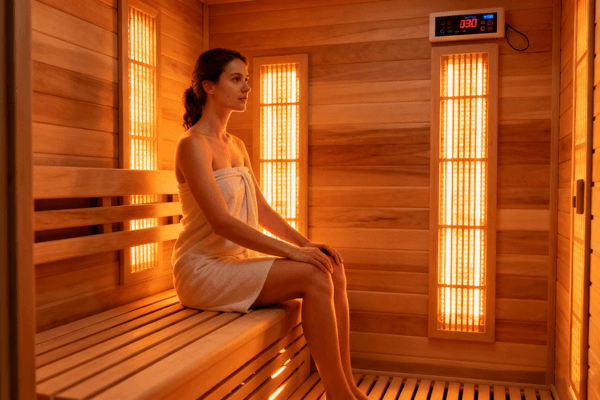
I follow infrared principles closely. Optimal heating time is 20–30 minutes. Always hydrate before and after sessions. Avoid common mistakes like exceeding max temperature. Infrared helps muscle recovery3, relieves tension, and enhances relaxation.
Optimal Heating Time & Temperature
| Aspect | Recommendation |
|---|---|
| Session Duration | 20–30 minutes |
| Temperature | 110–130°F (43–54°C) |
| Frequency | 3–4 times per week |
Hydration Tips
| Before Sauna | After Sauna |
|---|---|
| Drink water 15 min prior | Replenish electrolytes |
| Avoid alcohol | Light snack if needed |
I also link this knowledge to my article on Sauna and Massage Benefits4 for deeper wellness guidance5.
Where to Place Your Outdoor Sauna?
Outdoor placement impacts privacy, comfort, and exposure. Incorrect location can reduce usage frequency and effectiveness.
Choosing the right spot improves safety, enjoyment, and long-term sauna performance outdoors.
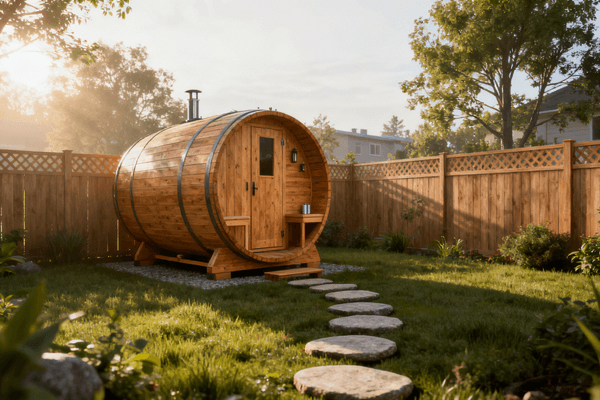
I evaluate options like backyard corners, decks, or gardens. Consider wind direction, shade, privacy6, and aesthetics. Landscaping with pathways and lighting enhances relaxation. Proper placement prevents exposure to elements and maximizes use.
Deck vs Backyard Corner vs Garden
| Location | Pros | Cons |
|---|---|---|
| Deck | Easy access, stable surface | May lack privacy |
| Backyard corner | More private, natural setting | Uneven ground may require leveling |
| Garden | Scenic, relaxing environment | More maintenance required |
Privacy & Wind Considerations
| Factor | Recommendation |
|---|---|
| Privacy | Screen with plants or fences |
| Wind | Position away from prevailing wind |
HOLIE outdoor sauna7 products are adaptable to these placements, combining durability with aesthetic design.
Best Spots to Install a Sauna Inside Your Home?
Indoor installation needs planning for space, moisture, and safety. Poor placement risks damage and reduces comfort.
Correct indoor placement8 ensures safety, energy efficiency, and enhanced wellness experience.
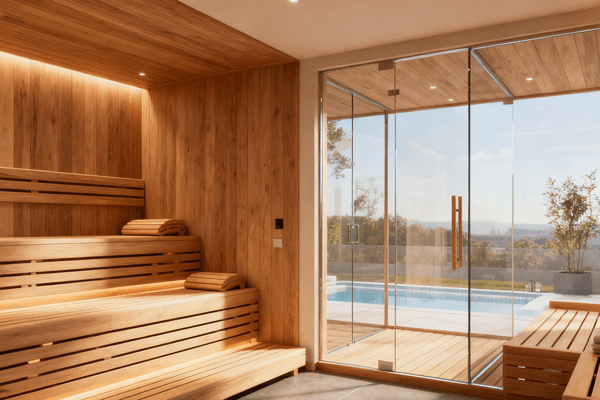
I explore basements, bathrooms, gyms, or unused corners. Electrical wiring and ventilation are critical. Proper insulation prevents moisture buildup9 and maintains efficiency.
Basement, Master Bathroom, Gym Room, Unused Corners
| Location | Pros | Cons |
|---|---|---|
| Basement | Quiet, large space | Humidity control needed |
| Master Bathroom | Convenience, privacy | Space limitation |
| Gym Room | Easy integration with fitness | Noise/ventilation concerns |
| Unused Corners | Cost-effective | Space may be small |
Electrical and safety compliance ensures safe long-term operation. I recommend Holie indoor sauna models for compact or flexible spaces.
How to Ventilate Your Sauna for Safety and Efficiency?
Ventilation affects air quality, heat distribution, and energy usage. Poor airflow reduces comfort and safety.
Proper ventilation ensures healthy air, even heat, and lower energy use in saunas.10

I arrange inlet vents near the heater and outlet vents opposite. Door placement affects airflow. Circulation must balance fresh air with heat retention. Regular checks prevent mold and maintain energy efficiency.11
Placement of Inlet & Outlet Vents
| Vent Type | Ideal Placement |
|---|---|
| Inlet | Near heater, low level |
| Outlet | Opposite wall, high level |
Door and heater alignment influences airflow. Proper arrangement improves sauna efficiency and comfort. HOLIE technical guides provide specific installation recommendations.
Choosing the Right Floor & Structure for Your Sauna?
Floor and structure determine durability, safety, and comfort. Wrong choice increases wear or accidents.
Selecting proper materials ensures heat resistance12, moisture control13, and long-lasting sauna performance.

I recommend wood for warmth and comfort. Tiles or concrete suit heavy-duty use. Insulation and structural materials must handle heat and moisture. Tables of pros and cons guide practical decisions.
Flooring Options
| Material | Pros | Cons |
|---|---|---|
| Wood | Warm, natural, comfortable | Requires maintenance |
| Tile | Easy to clean | Cold, slippery |
| Concrete | Durable, moisture-resistant | Hard surface |
Insulation & Structural Tips
| Aspect | Recommendation |
|---|---|
| Wall Insulation | High-grade, heat-resistant |
| Ceiling Insulation | Prevents heat loss |
| Moisture Control | Vapor barrier, proper sealing |
HOLIE sauna products provide optimized structural and flooring solutions for both indoor and outdoor installations.
Planning Infrared Sauna Power, Ceiling Height & Clearance?
Electric setup, panel placement, and space clearance influence safety and effectiveness. Incorrect planning risks injury or inefficiency.
Proper planning of electrical, height, and clearance ensures optimal infrared sauna operation.

I ensure electrical compliance with GFCI safety14. Ceiling height affects heat distribution. Infrared panels need safe distance from users and walls. Clearance planning supports comfort and energy efficiency.
Electrical & Ceiling Recommendations
| Aspect | Guideline |
|---|---|
| Power Supply | Dedicated circuit, GFCI |
| Ceiling Height | Minimum 7 feet |
| Panel Clearance | 6–12 inches from walls |
HOLIE installation services assist with accurate setup and safety compliance.
FAQ: Sauna Installation and Usage Questions?
Saunas bring questions about timing, placement, and safety. Clear guidance prevents misuse and enhances wellness.
Answers ensure safe usage, optimal placement, and proper ventilation for lasting benefits.

Common concerns include infrared session duration, small room placement, ventilation setup15, and sauna timing before or after massage. Detailed advice enhances safety and results.
Example Questions
| Question | Answer |
|---|---|
| How long to stay in infrared sauna16? | 20–30 minutes per session |
| Can I place a sauna in a small room? | Yes, with proper insulation and ventilation |
| What is safest ventilation setup? | Inlet near heater, outlet opposite |
| Should I sauna before or after massage? | Sauna before massage enhances muscle recovery |
HOLIE case studies demonstrate practical installations for both homes and wellness centers.
Conclusion
Proper sauna placement, structure, ventilation, and infrared use maximize safety, wellness, and comfort. Planning both indoor and outdoor installations carefully ensures energy efficiency, muscle recovery, and relaxation. Using Holie saunas with recommended clearances, panel arrangements, and flooring enhances long-term durability and enjoyment, making every session safer, more effective, and deeply restorative.
-
Discover expert advice on maximizing the benefits of infrared saunas for enhanced wellness. ↩
-
Learn why proper ventilation is crucial for safety and effectiveness in sauna use. ↩
-
Explore this link to understand how infrared saunas can enhance muscle recovery and overall performance. ↩
-
Exploring this link will provide you with comprehensive insights into how sauna and massage can enhance your overall wellness. ↩
-
This resource will help you discover various approaches and expert advice for achieving deeper wellness in your life. ↩
-
Learning about privacy solutions for outdoor spaces can help you create a more comfortable and secluded sauna experience. ↩
-
Exploring the benefits of outdoor saunas can enhance your understanding of their value and improve your sauna experience. ↩
-
Understanding the best practices for indoor sauna placement can enhance safety and comfort in your home. ↩
-
Preventing moisture buildup is crucial for maintaining sauna efficiency and longevity; explore effective strategies. ↩
-
Understanding the benefits of proper sauna ventilation can enhance your sauna experience and ensure safety. ↩
-
Learn effective strategies to prevent mold and improve energy efficiency in your sauna for a healthier environment. ↩
-
Understanding heat resistance is crucial for selecting materials that ensure safety and longevity in sauna construction. ↩
-
Effective moisture control is essential for maintaining sauna integrity and preventing damage, making this resource invaluable. ↩
-
Understanding GFCI safety is crucial for ensuring electrical safety in your sauna, preventing potential hazards. ↩
-
Learn about effective sauna ventilation setups to ensure safety and optimal performance in your sauna. ↩
-
Explore the benefits of infrared saunas to enhance your wellness routine and understand their unique advantages. ↩




